
By Eric SchmittPhotographs by Diana Zeyneb Alhindawi
Tuesday February 28, 2023

Somali soldiers, part of an elite combat unit called Danab, preparing for live fire drills at a military base in Baledogle, Somalia, earlier this month.
BALEDOGLE, Somalia — The promise and perils of America’s counterterrorism campaign were on full display at a remote training base in central Somalia.
It was graduation day for 346 recruits who would join an elite Somali commando unit trained by the State Department, advised by U.S. Special Operations forces, and backed by American air power.
Since last August, the unit, called Danab, has spearheaded a string of Somali army victories against Al Shabab, an Islamist terrorist group that is considered the deadliest of Al Qaeda’s global branches.
“We’re more dedicated than ever,” said Second Lt. Shukri Yusuf Ali, 24, who joined the unit two years ago as one of its few female members and was recently selected to attend the U.S. Army infantry training course at Fort Benning, Ga.
But sadness hung over the ceremony. Many of the recruits will be rushed to the front lines to backfill two Danab battalions decimated by a Shabab attack last month that left more than 100 Somali soldiers dead or injured.
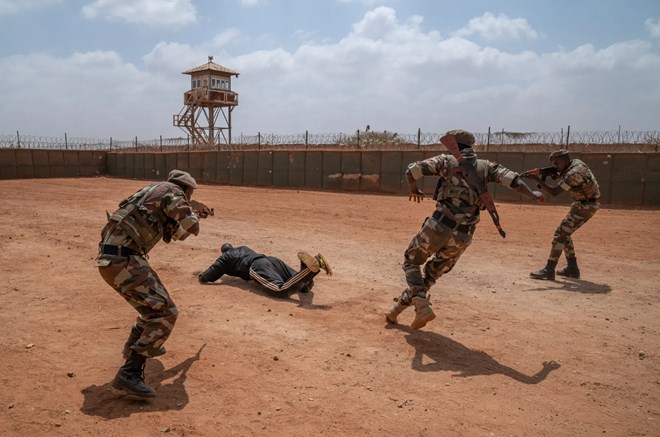
Danab recruits demonstrating how they would capture a suicide bomber. The unit has spearheaded a string of recent Somali army victories against Al Shabab.
I first reported from Somalia 30 years ago, when the U.S. military’s main mission there was to make the capital, Mogadishu, and outlying areas in a famine belt safe enough for aid deliveries, which had been interrupted by fighting among Somali factions.
The United States withdrew from the country after the “Black Hawk Down” episode of 1993, when Somali militia fighters killed 18 American service members in a blazing battle later depicted in books and Hollywood movies.
Now, nearly two decades after the rise of Al Shabab, Somalia is the most active front in the “forever wars” that the United States has been waging against Islamist extremists since the Sept. 11, 2001, terrorist attacks.
The American fight against Al Shabab began in 2014 with a handful of military advisers and grew steadily to a 700-member training force that President Donald J. Trump withdrew just before leaving office in 2021. President Biden restored 450 of the troops last year to advise Somali soldiers fighting a Shabab insurgency that still controls much of the country’s south.
Somalia is also the center of a U.S. counterterrorism drone war that has waned in other hot spots like Yemen, Libya and Pakistan’s tribal areas where U.S. airstrikes have diminished the threat. In the past year, the United States has carried out about 20 airstrikes in Somalia, down from a peak of 63 in 2019. Nearly all of the past year’s strikes, however, were in “collective self-defense” of Somali forces.
I returned to Somalia this month for a rare embed with U.S. Special Operations forces. The visit offered a window into a counterterrorism world in which a small number of Americans, usually far from the front lines, are advising and assisting Somali troops waging a ferocious daily fight against a formidable foe.
As U.S. commandos worked with their Somali counterparts, an array of American, Somali and other African military, diplomatic and aid officials expressed cautious optimism about the Somali government’s commitment to the fight but lingering doubts over its ability to hold the ground it retakes.
Now, in the wake of the attack on Jan. 20 in Galmudug state, in central Somalia, Somali officials have asked for more American firepower and renewed an appeal to Washington for more drone strikes and looser rules on when they can be carried out. The request so far has received a cool reception from the Biden administration, which is wary of a deeper military commitment.
The attack came as the Somali military pressed its monthslong offensive, with several powerful local clan militias joining the fight against a terrorist group that has wreaked havoc across the Horn of Africa. The Somali government has been resupplying the clan militias with ammunition and other aid.
Last May, Somalia elected a new president, Hassan Sheikh Mohamud, who also held the role from 2012 to 2017. Since returning to office, he has declared an all-out war on Al Shabab, vowing to limit their geographical reach and cut off their money. Intelligence officials estimate that the group has roughly 7,000 to 12,000 members and annual income — including from taxing or extorting civilians — of about $120 million.
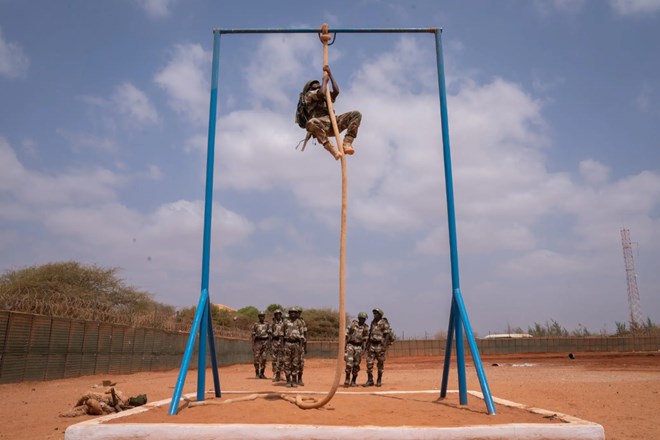
Danab recruits participating in exercises on their graduation day. Somalia’s president has declared an all-out war on Al Shabab.
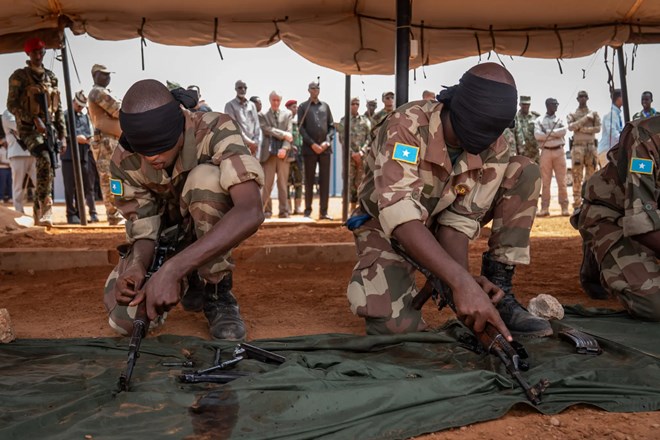
Danab recruits demonstrating how to assemble weapons in the dark.
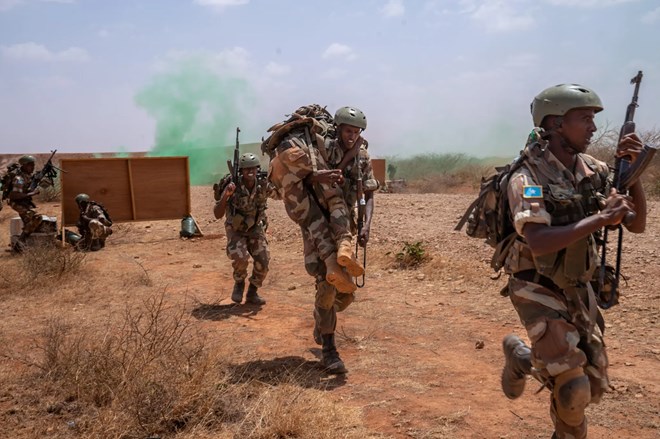
Live fire drills prepared the recruits for the imminent threat from Al Shabab on the front lines.
The full-scale offensive started soon after Mr. Biden redeployed American trainers to Somalia. Those forces only advise and assist Somali soldiers and do not conduct unilateral counterterrorism operations like the one last month by members of the Navy’s SEAL Team 6 that killed a senior Islamic State financier in northern Somalia.
Several Somali, U.S. and other Western officials and analysts said in interviews that the military campaign has been increasingly successful, retaking dozens of towns and villages.
But other officials struck a cautionary note about the way ahead, citing Al Shabab’s tenacity, Somalia’s history of dysfunction, the dizzying complexities of its clan dynamics, and a looming famine driven by drought.
“For the coming year, I don’t envision a significant reduction in Shabab’s capabilities,” said Heather Nicell, an Africa analyst with Janes, a London-based defense intelligence firm. “They’re adapting.”
Indeed, Al Shabab has responded with vicious counterattacks across the country, reclaiming some territory in a seesaw battle for control. In October, the group carried out the deadliest terrorist attack in Somalia in five years, killing 121 people and wounding about 300 others in a twin-car explosion that struck the Ministry of Education in Mogadishu, a city of around two million people.
More than 1,000 foreign diplomats, military trainers, U.N. workers, journalists and others operate inside a security zone near Mogadishu’s seaside international airport, largely sealed off from the metropolitan mayhem by giant concrete blast walls topped by concertina wires.
In early February, I took an Ethiopian Airlines flight to the city and stayed at a hotel steps from the airport exit. Outside my hotel window, a tan-camouflaged armored vehicle rumbled by. Over three days, a photographer colleague, Diana Zeyneb Alhindawi, and I conducted interviews in the security zone and flew aboard an Air Force C-130 cargo plane to this Somali military base 55 miles northwest of Mogadishu to watch live-fire training demonstrations and the graduation ceremony. We kept body armor and helmet at the ready in case of a Shabab attack.
The security zone walls can’t keep all violence at bay. Al Shabab occasionally lobs rounds inside, most recently on Feb. 1, when an 82-millimeter mortar slammed into a wall adjacent to the windowless, fortress-like U.S. Embassy, injuring four people.
The assignment is considered so dangerous that the State Department has barred the U.S. ambassador, Larry E. André Jr., a 33-year Foreign Service veteran, from venturing into the city itself. Even within the green zone, he travels in an armored vehicle with a security detail. Mr. André has made periodic visits elsewhere around the country, including to the graduation ceremony.
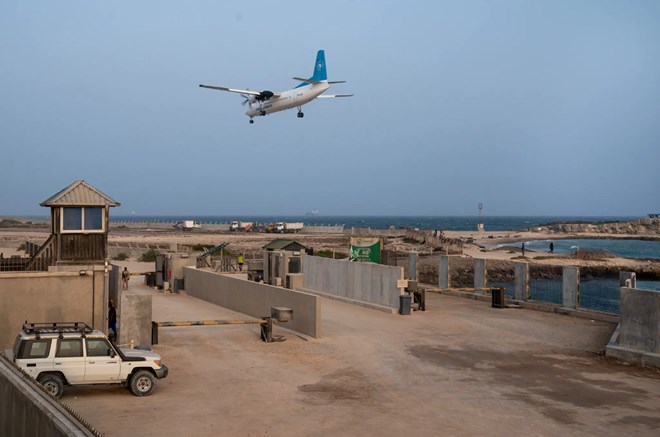
A commercial plane flying over the security zone in Mogadishu. Evens the concrete walls can’t keep all of the violence at bay.
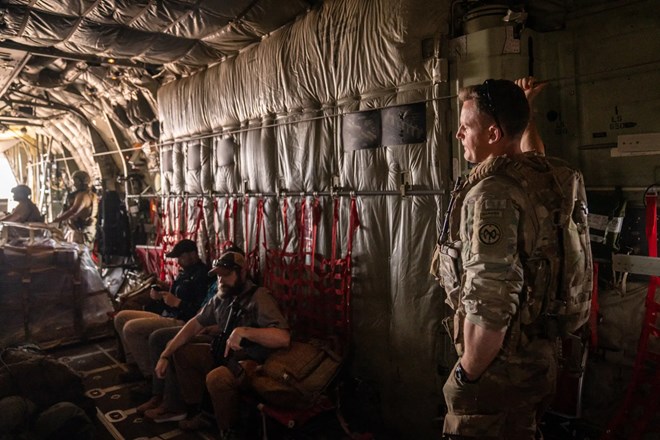
The United States is one of several countries advising and assisting the Somali government in its fight against Al Shabab.
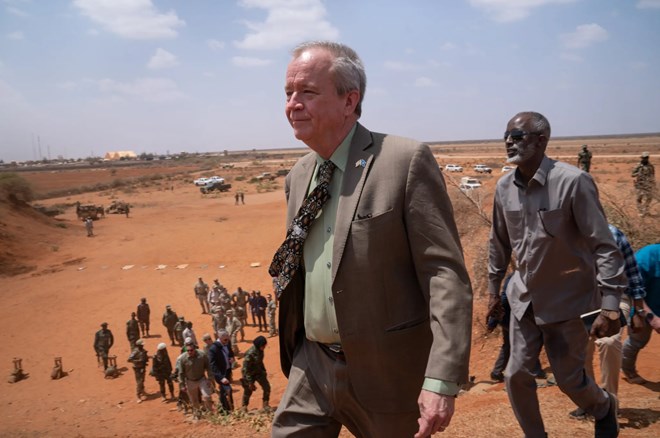
Larry E. André Jr., the U.S. ambassador, has made periodic visits elsewhere around the country, including to the graduation ceremony, but is barred from entering Mogadishu.
Soldiers for the Danab, which means lightning in Somali, are recruited by employees of Bancroft Global Development, a Washington-based company that for years has worked with the State Department to train African Union troops and embed with them on military operations in Somalia.
Recruits who pass physical exams, literacy tests and security background checks are then sent to Baledogle, where they undergo three months of combat training with Bancroft instructors.
The State Department spends about $80 million a year to train, equip, feed, fuel and provide $300 monthly bonuses to the Danab force, embassy officials said.
Some critics say the current Somali operations are too dependent on Danab, to the detriment of the larger, and evidently harder, job of building up the regular Somali army.
In the field, U.S. Special Operations forces, including Army Green Berets and Navy SEAL commandos, work closely with individual Danab units, advising on mission planning, intelligence gathering and troubleshooting.
When the Danab go out on operations, the U.S. advisers remain behind at small operating bases but monitor live video feeds of the operations from surveillance drones and reconnaissance aircraft.
If the Somali commandos run into trouble, they first seek help from Somali units nearby or Ugandan helicopter gunships. If all else fails, they call for American backup.
If the situation is dire enough — with the enemy attacking or threatening to — the U.S. advisers can authorize a collective self-defense airstrike, as they did most recently on Feb. 21, American officials said. Turkey also conducts airstrikes in support of Somali partners, the officials said.
The United States is one of several countries advising and assisting the Somali government in its fight against Al Shabab. In addition to the African Union, Turkey and Uganda, Britain, the United Arab Emirates, Eritrea and Egypt are also involved.
The hodgepodge of support poses major challenges for Somali commanders responsible for integrating the disparate elements into a cohesive fighting force.
“The new soldiers are being trained in different locations by different countries with different training methods, philosophies, equipment and even languages!” said Omar S Mahmood, a senior East Africa analyst for the International Crisis Group in Nairobi. “The lack of a common base inevitably complicates efforts to develop a coherent national army.”
President Mohamud is planning for the delivery of services to stabilize areas that have been newly liberated and is trying to forge stronger partnerships with both clan leaders and international allies. But this clan-based approach is unproven, some analysts say.
The Jan. 20 attack near the village of Gal’ad had the potential to deal the Danab, and the large-scale offensive, a crippling blow. Four car-bombers and 10 militants wearing suicide explosives vests stormed a Danab encampment at dawn, followed by withering heavy gunfire from about 100 Shabab fighters in what American officials called a “catastrophic attack.”
An American airstrike overnight scattered the Shabab fighters and the next day, surviving members of the bloodied Danab battalions joined with other Somali army units to fight back, officials said.
“There are going to be casualties,” said Comdr. Jonathan H., a Navy SEAL officer who is the U.S. Special Operations commander in Somalia. As part of being allowed access, The New York Times agreed to only partially identify him for security reasons. “But there are going to be many more successes if they continue building on the momentum. I’m cautiously optimistic about the progress being made.”
At the graduation ceremony two weeks after the attack, posters emblazoned with photographs of the fallen Danab fighters hung in memory around the army base. The camp will be renamed after Maj. Hassan Tuure, the Danab’s deputy commander who was killed in the assault.
For Lieutenant Ali, a former graphic artist in Mogadishu who designed the posters, there is no giving in to the extremists.
“I’m not afraid; I am not afraid of anything,” she told me, as we stood in a tent just steps from the ceremony where the hundreds of graduates occasionally burst into rhythmic chants and clapping. “I want to help the people of Somalia. They need me.”
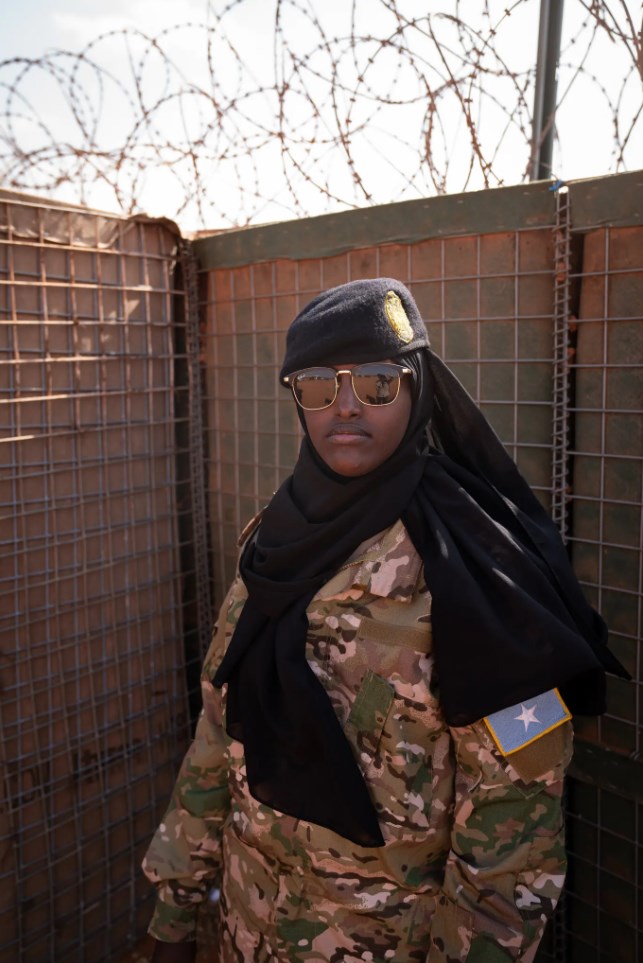 “We’re more dedicated than ever,” said Second Lt. Shukri Yusuf Ali, 24, who joined the Danab two years ago as one of its few female members.
“We’re more dedicated than ever,” said Second Lt. Shukri Yusuf Ali, 24, who joined the Danab two years ago as one of its few female members.
Charlie Savage in Washington and Declan Walsh in Nairobi contributed reporting.
Eric Schmitt is a senior writer who has traveled the world covering terrorism and national security. He was also the Pentagon correspondent. A member of the Times staff since 1983, he has shared four Pulitzer Prizes. @EricSchmittNYT